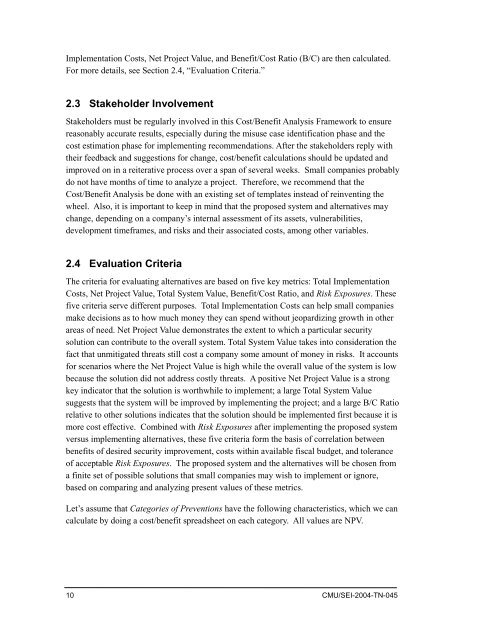SQUARE Project: Cost/Benefit Analysis Framework for Information ...
SQUARE Project: Cost/Benefit Analysis Framework for Information ...
SQUARE Project: Cost/Benefit Analysis Framework for Information ...
Create successful ePaper yourself
Turn your PDF publications into a flip-book with our unique Google optimized e-Paper software.
Implementation <strong>Cost</strong>s, Net <strong>Project</strong> Value, and <strong>Benefit</strong>/<strong>Cost</strong> Ratio (B/C) are then calculated.<br />
For more details, see Section 2.4, “Evaluation Criteria.”<br />
2.3 Stakeholder Involvement<br />
Stakeholders must be regularly involved in this <strong>Cost</strong>/<strong>Benefit</strong> <strong>Analysis</strong> <strong>Framework</strong> to ensure<br />
reasonably accurate results, especially during the misuse case identification phase and the<br />
cost estimation phase <strong>for</strong> implementing recommendations. After the stakeholders reply with<br />
their feedback and suggestions <strong>for</strong> change, cost/benefit calculations should be updated and<br />
improved on in a reiterative process over a span of several weeks. Small companies probably<br />
do not have months of time to analyze a project. There<strong>for</strong>e, we recommend that the<br />
<strong>Cost</strong>/<strong>Benefit</strong> <strong>Analysis</strong> be done with an existing set of templates instead of reinventing the<br />
wheel. Also, it is important to keep in mind that the proposed system and alternatives may<br />
change, depending on a company’s internal assessment of its assets, vulnerabilities,<br />
development timeframes, and risks and their associated costs, among other variables.<br />
2.4 Evaluation Criteria<br />
The criteria <strong>for</strong> evaluating alternatives are based on five key metrics: Total Implementation<br />
<strong>Cost</strong>s, Net <strong>Project</strong> Value, Total System Value, <strong>Benefit</strong>/<strong>Cost</strong> Ratio, and Risk Exposures. These<br />
five criteria serve different purposes. Total Implementation <strong>Cost</strong>s can help small companies<br />
make decisions as to how much money they can spend without jeopardizing growth in other<br />
areas of need. Net <strong>Project</strong> Value demonstrates the extent to which a particular security<br />
solution can contribute to the overall system. Total System Value takes into consideration the<br />
fact that unmitigated threats still cost a company some amount of money in risks. It accounts<br />
<strong>for</strong> scenarios where the Net <strong>Project</strong> Value is high while the overall value of the system is low<br />
because the solution did not address costly threats. A positive Net <strong>Project</strong> Value is a strong<br />
key indicator that the solution is worthwhile to implement; a large Total System Value<br />
suggests that the system will be improved by implementing the project; and a large B/C Ratio<br />
relative to other solutions indicates that the solution should be implemented first because it is<br />
more cost effective. Combined with Risk Exposures after implementing the proposed system<br />
versus implementing alternatives, these five criteria <strong>for</strong>m the basis of correlation between<br />
benefits of desired security improvement, costs within available fiscal budget, and tolerance<br />
of acceptable Risk Exposures. The proposed system and the alternatives will be chosen from<br />
a finite set of possible solutions that small companies may wish to implement or ignore,<br />
based on comparing and analyzing present values of these metrics.<br />
Let’s assume that Categories of Preventions have the following characteristics, which we can<br />
calculate by doing a cost/benefit spreadsheet on each category. All values are NPV.<br />
10 CMU/SEI-2004-TN-045
















